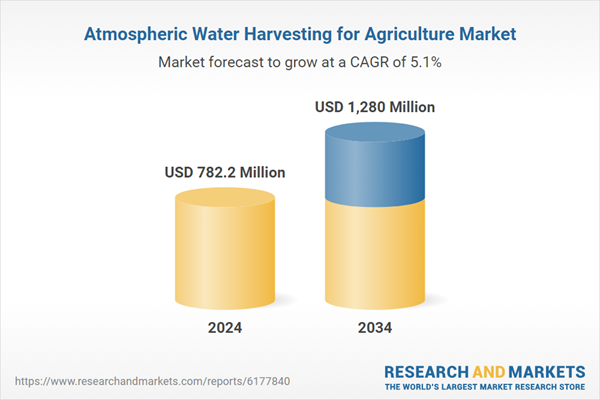This market is experiencing growth due to the escalating impact of climate change, including rising global temperatures and unpredictable rainfall patterns, which are worsening water scarcity. AWH offers a decentralized, sustainable solution for extracting moisture from the air to provide water in locations with limited access to conventional water sources. These systems are particularly suited for remote agricultural zones, where infrastructure is minimal or non-existent, and they help smallholder farmers reduce dependency on seasonal rainfall and unreliable water distribution systems.
AWH systems provide significant advantages over traditional water generation technologies. Unlike desalination, AWH does not produce harmful brine and can function with minimal power, especially when solar powered. The industry has seen advances in materials science and system efficiency, leading to improved condensation surfaces, energy-saving desiccants, and smart solar integration. Some of the newer units can generate up to 80 liters per hour, making them increasingly viable for larger-scale agricultural operations. These systems are also crucial for disaster response, as they offer portable, reliable water sources when traditional supply chains are disrupted by environmental catastrophes or emergency events.
The cooling condensation systems generated USD 319.1 million in 2024 and are projected to grow at a CAGR of 3.9% between 2025 and 2034, driven by the technical maturity of these systems and their operational simplicity, which makes them easier to deploy and scale across varied agricultural terrains. These systems continue to attract attention due to their adaptability and relatively lower upfront costs, which appeal to a broad range of agricultural stakeholders.
The low-capacity below 100 liters per day segment held a 43% share in 2024 and generated USD 336 million. These smaller-scale systems are particularly popular in early-stage deployments, experimental installations, and small-scale farms. Their compact design, portability, and affordability have positioned them as the go-to solution for pilot projects and decentralized irrigation in emerging agricultural economies.
U.S. Atmospheric Water Harvesting for Agriculture Market generated USD 136.2 million and is forecast to grow at a CAGR of 5.9% through 2034. The United States is emerging as a frontrunner in innovation within this space, with significant research and development efforts targeting high-efficiency water extraction techniques. Advanced systems are being engineered to operate in extremely arid environments, expanding the reach of AWH into historically water-stressed agricultural zones. Government agencies and research institutions are also investing in AWH for military logistics and disaster response, creating pathways for broader commercialization in agricultural use cases.
Leading players shaping the Global Atmospheric Water Harvesting for Agriculture Market include GENAQ, Watergen, WAVR Technologies, RussKap Water, Skywell, Genesis Systems, Tsunami Products, Inc., AWG Water Harvesting, Atlantis Solar, Air2Water, Aeronero, atoco, Aquatech International, Maithri Aquatech Pvt. Ltd., and AT Company. To gain a competitive advantage in the Atmospheric Water Harvesting for Agriculture Market, companies are employing a mix of strategies, including partnerships with agricultural cooperatives, local governments, and NGOs to scale deployment in rural areas. Innovation remains central, and firms are investing heavily in solar integration, autonomous operation, and IoT-connected monitoring. Several manufacturers are expanding their product lines across different capacity ranges to serve both smallholder farms and large agribusinesses. Localization of production and regional customization are also becoming key to improving adoption, alongside government-backed pilot programs and participation in climate-resilience initiatives.
Comprehensive Market Analysis and Forecast
- Industry trends, key growth drivers, challenges, future opportunities, and regulatory landscape
- Competitive landscape with Porter’s Five Forces and PESTEL analysis
- Market size, segmentation, and regional forecasts
- In-depth company profiles, business strategies, financial insights, and SWOT analysis
This product will be delivered within 2-4 business days.
Table of Contents
Companies Mentioned
The companies profiled in this Atmospheric Water Harvesting for Agriculture market report include:- Aeronero
- Air2Water
- Aquatech International
- AT Company
- Atlantis Solar
- Atoco
- AWG Water Harvesting
- GENAQ
- Genesis Systems
- Maithri Aquatech Pvt. Ltd.
- RussKap Water
- Skywell
- Tsunami Products, Inc.
- Watergen
- WAVR Technologies
Table Information
| Report Attribute | Details |
|---|---|
| No. of Pages | 166 |
| Published | September 2025 |
| Forecast Period | 2024 - 2034 |
| Estimated Market Value ( USD | $ 782.2 Million |
| Forecasted Market Value ( USD | $ 1280 Million |
| Compound Annual Growth Rate | 5.1% |
| Regions Covered | Global |
| No. of Companies Mentioned | 16 |









